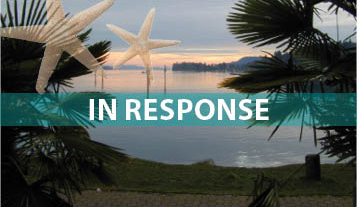BY BRIAN PYPER
The North Salt Spring Waterworks District (NSSWD) is receiving feedback regarding our moratorium review, and I’d like to respond to some questions that have emerged from our month-long public engagement. I want ratepayers and the community at large to know that we actively encourage their input and strive to provide full transparency regarding this work. Among current staff and trustees, our efforts are driven by concern for our future water supply and health of the Maxwell Lake and St. Mary Lake watersheds.
First, concerns regarding “mixing” water between systems (e.g., invasive species) suggest that somewhere in our public communications or consultant’s report (“St. Mary Lake and Maxwell Lake Reliability Assessment” by KWL Engineering), it was implied that raw water would be moved from one lake to another. That is not the case. The proposed combining of the systems refers exclusively to the distribution of treated water. For historical reasons, water service for the two systems has been kept separate in terms of connections, except in emergency conditions. Once the Maxwell treatment plant is completed, and hence water quality is similar between the systems, we can service connections within either system from either lake where pressure allows. There is zero concern here regarding mixing pathogens, invasive species, etc., between the two systems. Instead, there is a big opportunity to benefit water supply, as I note below.
Second, we expect that Rippon Creek diversions will have little impact on overall watershed health. We are licensed to divert 100 per cent of that water into Maxwell Lake, but only from Nov. 1 through March 31 (the rainy and cool “winter” season). No diversion occurs from April through October. During the winter diversion period, the vast majority of diverted water would end up in the ocean. However, we’ve rarely been able to divert more than 50 per cent of Rippon Creek water (closer to five per cent in recent years) due to high turbidity and phosphorus concerns. We’re addressing these concerns in two ways: (1) reducing road run-off as part of the CARL project (a key initiative we’re supporting for ecosystem integrity and fire reduction in the Maxwell watershed through Ruth Waldick and Transition Salt Spring); and (2) designing the future Maxwell treatment plant so that all diverted water enters the plant and not the lake.
Regarding climate projections, this modelling work will always have a wide range of uncertainty (and criticism). Compared to previous KWL reports, the current analysis is much improved because it provides results based on monthly temperature and precipitation projections across a range of climate models that are recommended by the Pacific Climate Impacts Consortium from the University of Victoria. We have also tried to ensure that the recent KWL report (a) displays results to clearly characterize the high variability (uncertainty) in model outcomes, (b) acknowledges the key assumptions underlying the hydrological models, and (c) limits recommendations to the hydrology assumptions and not to potential water availability (that’s the job of NSSWD staff and board).
So we are now at the decision-making stage, working with the following findings from Phase 1 and 2 of our work. (1) There is available water supply at Maxwell, now and 60 years from now, to reliably support additional connections. The moratorium in 2015 was extended to Maxwell Lake because of concerns over recharge, but results of the hydrology modelling clearly indicate that there is available supply. (2) The St. Mary side does not have available supply, and will be worse off in a warmer future, which is not a surprise. In most summers, the lake is drawn down close to our provincial limit due to demand and evaporation (St. Mary has a much larger surface area than Maxwell). (3) An opportunity to improve both systems: raising the weir at St. Mary Lake and building the Maxwell treatment plant to handle full-system operation and receive direct Rippon Creek inflows. (4) A recommendation to combine the two distribution systems so Maxwell can support the St. Mary side during the critical summer period, and St. Mary can assist Maxwell refill during the winter period (when in most years a huge volume of water is leaving St. Mary via Duck Creek to the ocean). These are first steps for developing a long-term vision for a reliable water supply. The planned system improvements will also include a new water conservation and demand management strategy planned for 2025.
Ultimately, this decision-making process will be sufficiently formalized and documented to be transparent to ratepayers and hopefully establish strong guidance for future boards. The proposed partial lifting of the moratorium was not an easy decision and not taken lightly, and certainly not due to any development interests. We want the best available science guiding this process, recognizing that there is only so much a relatively small agency can spend to refine that science.
We greatly appreciate the feedback received from residents in October to help the board with our decision-making process. We will review the comments received at our November and December meetings, and your feedback will be welcome at these meetings as well.
The writer is chair of the North Salt Spring Waterworks District board of trustees.

